
Bebop or bop is a style of jazz developed in the early-to-mid-1940s in the United States. The style features compositions characterized by a fast tempo, complex chord progressions with rapid chord changes and numerous changes of key, instrumental virtuosity, and improvisation based on a combination of harmonic structure, the use of scales and occasional references to the melody.
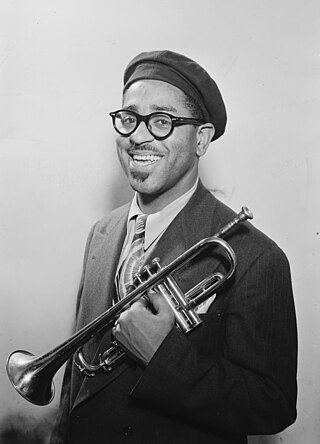
John Birks "Dizzy" Gillespie was an American jazz trumpeter, bandleader, composer, educator and singer. He was a trumpet virtuoso and improviser, building on the virtuosic style of Roy Eldridge but adding layers of harmonic and rhythmic complexity previously unheard in jazz. His combination of musicianship, showmanship, and wit made him a leading popularizer of the new music called bebop. His beret and horn-rimmed spectacles, scat singing, bent horn, pouched cheeks, and light-hearted personality have made him an enduring icon.
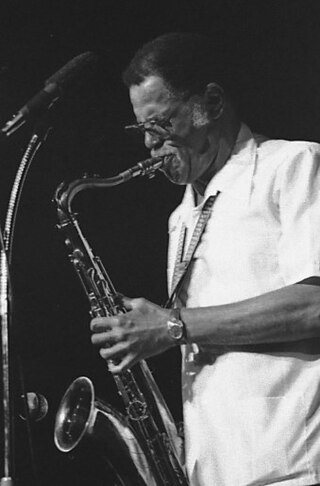
Dexter Gordon was an American jazz tenor saxophonist, composer, and bandleader. He was among the most influential early bebop musicians, which included other greats such as Charlie Parker, Dizzy Gillespie, and Bud Powell. Gordon's height was 6 feet 6 inches (198 cm), so he was also known as "Long Tall Dexter" and "Sophisticated Giant". His studio and performance career spanned more than 40 years.

William Clarence Eckstine was an American jazz and pop singer and a bandleader during the swing and bebop eras. He was noted for his rich, almost operatic bass-baritone voice. In 2019, Eckstine was posthumously awarded the Grammy Lifetime Achievement Award "for performers who, during their lifetimes, have made creative contributions of outstanding artistic significance to the field of recording." His recording of "I Apologize" was given the Grammy Hall of Fame Award in 1999. The New York Times described him as an "influential band leader" whose "suave bass-baritone" and "full-throated, sugary approach to popular songs inspired singers like Earl Coleman, Johnny Hartman, Joe Williams, Arthur Prysock, and Lou Rawls."

Tadley Ewing Peake Dameron was an American jazz composer, arranger, and pianist.
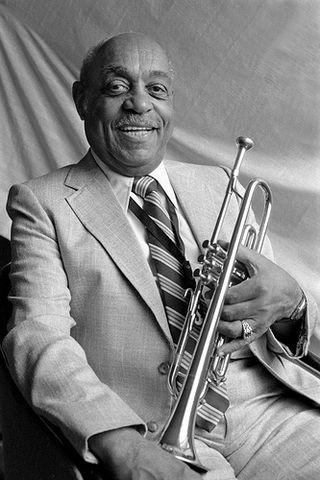
Bennett Lester Carter was an American jazz saxophonist, clarinetist, trumpeter, composer, arranger, and bandleader. With Johnny Hodges, he was a pioneer on the alto saxophone. From the beginning of his career in the 1920s, he worked as an arranger including written charts for Fletcher Henderson's big band that shaped the swing style. He had an unusually long career that lasted into the 1990s. During the 1980s and 1990s, he was nominated for eight Grammy Awards, which included receiving a Lifetime Achievement Award.

Theodore "Fats" Navarro was an American jazz trumpet player and a pioneer of the bebop style of jazz improvisation in the 1940s. A native of Key West, Florida, he toured with big bands before achieving fame as a bebop trumpeter in New York. Following a series of studio sessions with leading bebop figures including Tadd Dameron, Bud Powell, and Kenny Clarke, he became ill with tuberculosis and died at the age of 26. Despite the short duration of his career, he had a strong stylistic influence on trumpet players who rose to fame in later decades, including Clifford Brown and Lee Morgan.
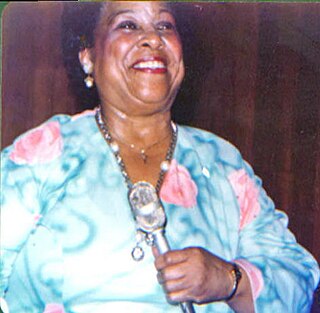
Helen Humes was an American singer. Humes was a teenage blues singer, a vocalist with Count Basie's band, a saucy R&B diva, and a mature interpreter of the classic popular song.

James Charles Heard was an American swing, bop, and blues drummer.
"A Night in Tunisia" is a musical composition written by American trumpeter Dizzy Gillespie around 1940–1942. He wrote it while he was playing with the Benny Carter band. It has become a jazz standard. It is also known as "Interlude", and with lyrics by Raymond Leveen was recorded by Sarah Vaughan in 1944.

Melba Doretta Liston was an American jazz trombonist, arranger, and composer. Other than those playing in all-female bands, she was the first woman trombonist to play in big bands during the 1940s and 1960s, but as her career progressed she became better known as an arranger, particularly in partnership with pianist Randy Weston. Other major artists with whom she worked include Dizzy Gillespie, Billie Holiday, John Coltrane, and Count Basie.

Velma Middleton was an American jazz vocalist and entertainer who sang with Louis Armstrong's big bands and small groups from 1942 until her death.
Charles Lawrence Persip, known as Charli Persip and formerly as Charlie Persip, was an American jazz drummer.
Walter Gilbert "Gil" Fuller was an American jazz arranger. He is no relation to the jazz trumpeter and vocalist Walter "Rosetta" Fuller.
"Groovin' High" is an influential 1945 song by jazz composer and trumpeter Dizzy Gillespie. The song was a bebop mainstay that became a jazz standard, one of Gillespie's best known hits, and according to Bebop: The Music and Its Players author Thomas Owens, "the first famous bebop recording". The song is a complex musical arrangement based on the chord structure of the 1920 standard originally recorded by Paul Whiteman, "Whispering", with lyrics by John Schonberger and Richard Coburn (né Frank Reginald DeLong; 1886–1952) and music by Vincent Rose. The biography Dizzy characterizes the song as "a pleasant medium-tempo tune" that "demonstrates...[Gillespie's] skill in fashioning interesting textures using only six instruments".
Rhythm in a Riff is a 1947 medium length musical film produced by William D. Alexander and directed by Leonard Anderson. The film stars Billy Eckstine and his band performing as well as Ann Baker, Hortense Allen Jordan, Sarah Harris, and Emmett "Babe" Wallace. The film is extant. The film was.made in New York City. It was released by Astor Pictures. The film was targeted to am African American audience, features and African American cast, and was produced and directed by African Americans. The film is also known as Flicker Up.

Dizzy Gillespie at Newport is a 1957 live album by Dizzy Gillespie, featuring his big band, recorded at the 1957 Newport Jazz Festival.
"Our Delight" is a 1946 jazz standard, composed by Tadd Dameron. It is considered one of his best compositions along with "Good Bait", "Hot House", "If You Could See Me Now", and "Lady Bird". It has an AABA construction. A moderately fast bebop song, it featured the trumpeter Fats Navarro, who is said to "exhibit mastery of the difficult chord progression". One author said, "'Our Delight' is a genuine song, a bubbly, jaggedly ascending theme that sticks in one's mind, enriched by harmonic interplay between a flaming trumpet section led by Dizzy, creamy moaning reeds and crooning trombones. The written accompaniments to the solos-in particular the leader's two statements-are full of inventiveness, creating call-and-response patterns and counter-melodies. What is boppish here is the off-center, syncopated melody, as well as the shifting, internal voicings of the chords, especially at the very end. These voicings, along with a love of tuneful melodies that one walks out of a jazz club humming, were Tadd's main legacy to such composers and arrangers as Benny Golson, Gigi Gryce, and Jimmy Heath." Rolling Stone describes it as a "bop gem". The first publication is by Dizzy Gillespie in August 1946. In total there are more than 120 covers of Our Delight. Bill Evans recorded his version of it for his debut album New Jazz Conceptions in 1956.
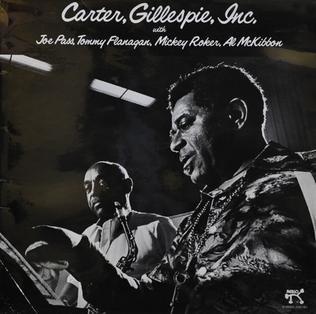
Carter, Gillespie Inc. is an album by saxophonist Benny Carter and trumpeter Dizzy Gillespie recorded in 1976 and released on the Pablo label.













